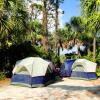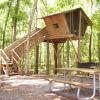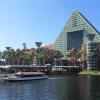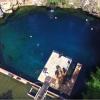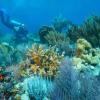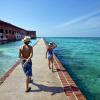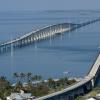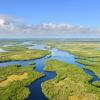By Laura Spinale
I’m standing near Pensacola Pass, a deep-water artery allowing large ships to travel from the Gulf of Mexico into Pensacola Bay. The bay swirls before me, heavy and gray. Raindrops large enough to make a “plonk” sound are falling.
These iron-fist images fit with my work today, writing about the decommissioned USS Oriskany. The aircraft carrier rests roughly 22 miles southeast of the pass, in waters 212 feet deep. She’s now the planet’s largest artificial reef. Those in the know call her the “Mighty O.” To the wags at CNN, she’s the “great carrier reef.”
The ship was named for a pivotal Revolutionary War battle, staged in Oriskany, N.Y. Commissioned at the tail end of World War II, the Essex Class carrier saw no action until Korea. She undertook innumerable operations off the coast of that nation, and off Vietnam. At 911 feet, she was capable of traveling 33 knots, and displacing 30,080 tons of water. Her complement? 3,460 persons.
In 1963, U.S. President John F. Kennedy boarded Oriskany (then stationed in San Diego), to witness military-preparedness operations. A decade before Kennedy’s visit, the William Holden/ Grace Kelly classic The Bridges at Toko-Ri was filmed aboard the Mighty O’s decks.
In October 1967, a young Navy pilot took off in his A-4 Skyhawk from Oriskany. He was shot down by a missile over North Vietnam. The enemy held him for more than five years, mostly at the North Vietnamese POW camp now infamously known as the Hanoi Hilton. The pilot’s name was John McCain.
I only mention this because I think you should know what you’re seeing.
Sunken
Decommissioned on Sept. 30, 1976, Oriskany was, on May 17, 2006, sunk to begin a new mission as an artificial reef and premier fishing and diving destination for northwest Florida (The event was part of a Navy program to recycle and reef decommissioned ships for long-term marine and economic benefits).
The sinking entailed 22 remotely controlled nearly simultaneous internal explosions that disabled valves and initiated the flooding process. Oriskany did not give up easily: it took her 38 minutes to go down. She now rests on the soft, sandy bottom of the Gulf of Mexico.
Oriskany is accessible to a variety of divers, including both the recreational type (typically those who employ only one tank, and who reach a maximum depth of 130 feet), and technical divers (those trained to go deeper). Whatever your abilities, you should know that the Mighty O has quickly become a must-dive, drawing scuba aficionados from Australia, Japan, Russia, Sweden and, in fact, most of Europe.
Pensacola-area charters running dives to the Mighty O include MBT Divers. Floating above all 911 feet of the Mighty O is an awe-inspiring sight. Recreational divers can explore the ships “Island,” which sits atop the flight deck and is nearly 200 feet long. The Island contains the ships navigation bridge, from where the captain controlled the ship, the flag bridge, the pilot house, radar and navigation equipment and much more. (Technical divers can, of course, explore deeper into the vessel.) Visibility runs from 75 to 300 feet.
Fish Ahoy
Those scuba diving the Mighty O these days find themselves in the company of goliath grouper, sunfish, eagle rays, tuna, amberjack and tropical fish. Their variety and number increase from week to week. So, too, do the fishing opportunities.
However, it takes marine life time to get used to the concept of a new reef, to discover it. Think of it the way you would construction of a new shopping center: it takes the locals a while to find their way over.
As you dive or fish the Mighty O, remember that the ship joins a veritable family of ocean vessels reefed here. USS Massachusetts, sunk more than 50 years ago near Pensacola Pass, sits in just 20-30 feet of water. Antares, a 387-foot freighter, lies 21 miles southeast of the pass, in depths from 80-130 feet. You can dive these and other vessels for sights of grouper, nurse sharks, stingrays, sea turtles and king mackerels. And since these vessels have had some time on the ocean floor, the fishing’s not bad, either.
PLACES TO REMEMBER
RELATED CONTENT
Pensacola's Natural Lure
- 5 minute read
Fishing, sailing, hiking and birding make Pensacola a nature-lover's ideal destination. From the "Canoe Capital of Florida" to the...
10 Florida Trails You Need to Experience
- 5 minute read
Want to experience the splendor of greenways and trails? Florida's your place. Outdoor enthusiasts are encouraged to step off of the beaten path...
Great Hiking Trails in Florida
- 10 minute read
By Lauren Tjaden With varied terrain and tremendous ecological diversity, Florida provides hikers of every skill level a perfect backdrop for exercise...


